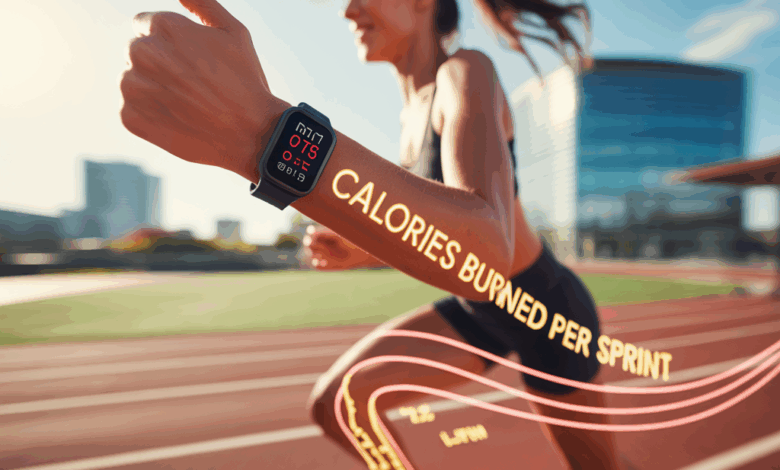How Many Calories Does Sprinting Burn? Real Numbers, Workouts & Tips

Ever stared at your watch after a blistering 20-second sprint and wondered, “Was that even worth it?” Or asked yourself whether sprint intervals beat steady jogging for fat loss? If you want a clear, practical answer to “how many calories does sprinting burn” — plus sample workouts, realistic estimates, and proven tips to get results — you’ve landed in the right place.
Why sprinting is different from steady-state running
Sprinting is an anaerobic, high-intensity activity that pushes your heart rate and muscles into short, powerful efforts. Unlike steady-state running, sprints create a large metabolic disturbance that not only burns calories during the workout but also increases post-exercise oxygen consumption (EPOC), sometimes called the afterburn effect. That means sprinting can be a highly time-efficient way to burn calories and boost your metabolism.
How many calories does sprinting burn — a realistic breakdown
The exact number of calories burned sprinting depends on several factors: your body weight, sprint intensity, sprint duration, rest intervals, and your fitness level. Below are practical ranges and a simple way to estimate your calorie burn.
Rough calorie ranges
- Short maximal sprints (20–30 seconds): about 8–15 calories per sprint for a 150–200 lb person, depending on intensity and rest.
- High-intensity interval sessions (20 minutes total, including rests): roughly 200–400 calories for most people.
- Continuous all-out efforts (rarely sustainable): can exceed 500 calories/hour equivalent, but most sprint workouts are interval-based.
These are estimates — you’ll get more accurate numbers by using a formula or wearable that uses heart rate and personal metrics.
How to estimate calories yourself (simple formula)
A practical method uses MET values (Metabolic Equivalent of Task):
- Calories burned ≈ MET × weight (kg) × duration (hours)
High-intensity sprint intervals typically range from ~8 to 16 METs depending on speed and effort. Example: a 70 kg (154 lb) person doing 20 minutes of sprint intervals at an average of 12 METs:
Calories ≈ 12 × 70 × (20/60) = 280 kcal
This gives you a reasonable ballpark and helps explain the wide range you’ll see in different workouts.
Real-world sprint workout examples and expected calorie burn
Below are practical sessions with approximate calorie burns for a 150 lb (68 kg) and 200 lb (91 kg) person. Adjust intensities and rest to match your level.
Workout A — Beginner intervals (20 minutes)
- Warm-up: 5 minutes easy jog + dynamic stretches
- 8 × 20 sec sprint, 70 sec walk/jog recovery
- Cool-down: 5 minutes easy jog
Estimated calories: 200–280 kcal (150 lb), 260–360 kcal (200 lb)
Workout B — Tabata-style (16 minutes)
- Warm-up: 8 minutes
- 6–8 rounds of Tabata: 20 sec all-out, 10 sec rest (4 min per block including recovery)
- Cool-down: 5–8 minutes
Estimated calories: 220–350 kcal (150 lb), 300–450 kcal (200 lb). Tabata is brutal but efficient — great for conditioning and EPOC.
Workout C — Hill sprints (30 minutes)
- Warm-up: 10 minutes
- 10 × 8–12 second uphill sprints with full recovery (90–120 secs)
- Cool-down: 8–10 minutes
Estimated calories: 300–450 kcal (150 lb), 380–540 kcal (200 lb). Hills increase power and calorie burn while reducing impact compared to flats.
Practical tips to maximize calorie burn and stay injury-free
- Warm up thoroughly: 8–12 minutes of dynamic movement prevents injury and improves performance.
- Prioritize quality over quantity: short, hard sprints with full recovery are more effective than many poor-quality reps.
- Frequency: 2–3 sprint sessions per week mixed with strength and low-intensity cardio is a sustainable balance.
- Progress gradually: increase sprint reps or intensity week-to-week, not both at once.
- Fuel and recover: sprinting depletes glycogen — eat a balance of protein and carbs around sessions and aim for good sleep.
- Use variety: mix hill sprints, track repeats, tempo runs, and sled pulls to avoid plateaus and reduce overuse injury.
Health benefits beyond calories burned
Sprinting improves anaerobic power, increases lean muscle (especially in the posterior chain), raises resting metabolic rate, and can improve insulin sensitivity. For many people, sprint training offers better time-efficiency for fat loss and cardiovascular adaptations than long, slow runs.
Common mistakes people make with sprint training
- Skipping the warm-up—this increases injury risk with high-intensity efforts.
- Doing too many sprints too soon—overtraining and poor mechanics can lead to hamstring or Achilles issues.
- Neglecting strength work—sprint performance and longevity improve when you also lift weights for power and stability.
Frequently Asked Questions
On average, a 20-minute sprint interval session can burn about 200–400 calories depending on your weight, intensity, and rest periods. Use the MET-based estimate (MET × weight(kg) × duration(hours)) for a personalized number.
Sprinting is more time-efficient and can produce a larger afterburn (EPOC), which helps with fat loss. However, the best approach combines sprinting with strength training and steady-state cardio, and aligns with your fitness level and injury history.
For most recreational athletes, 2–3 sprint sessions per week combined with strength training and recovery days is optimal. Beginners may start with one quality sprint session and progress as fitness and recovery improve.
Conclusion — Take action with smart sprinting
Sprinting can burn substantial calories in a short time and deliver benefits beyond simple calorie math — improved power, metabolic boost, and efficient fat loss. To answer the core question, “how many calories does sprinting burn”: expect a wide but usable range (roughly 200–400 kcal for a typical 20-minute interval session) and personalize the estimate using your weight and intensity. Ready to try a sprint plan? Start with the beginner interval above, complement it with strength work, and check out our workout routines and nutrition guides for meal and training pairings. If you want recovery and lifestyle tips, see our wellness tips page.
Want a custom sprint workout tailored to your weight and goals? Drop a comment or try a guided session — your fastest, leanest self might be just a few sprints away.




